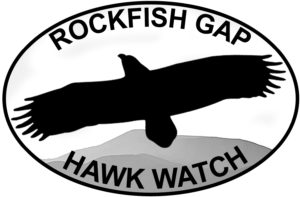 Terminology you’ll probably hear at the hawk watch
Terminology you’ll probably hear at the hawk watch
Accipiter – A genus of 50 largely forest-dwelling species of raptors with short, rounded wings and long tails. Eastern North American representatives include the Sharp-shinned Hawk, Cooper’s Hawk, and Northern Goshawk. The group is known for its rapid, maneuverable flight, and for its flap-flap-flap-glide flight pattern.
Atlantic Flyway – Migration flyway along the Atlantic coast of North America, consisting of Canadian provinces New Brunswick, Nova Scotia, Ontario, Quebec and U.S. states Connecticut, Delaware, Florida, Georgia, Maine, Maryland, Massachusetts, New Hampshire, New Jersey, New York, North Carolina, Pennsylvania, Rhode Island, South Carolina, Vermont, Virginia, and West Virginia.
Bins – A short version of the word ‘binoculars’
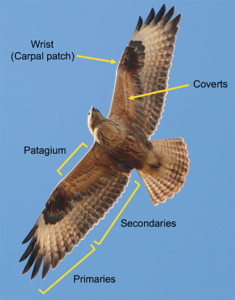 Bird! – When a hawk watcher is staring intently at the sky and yells, “Bird!” that means – “Pay attention everyone, there is a hawk up there, too far off to identify yet, so get on it and let’s see what we’ve got!”
Bird! – When a hawk watcher is staring intently at the sky and yells, “Bird!” that means – “Pay attention everyone, there is a hawk up there, too far off to identify yet, so get on it and let’s see what we’ve got!”
Buteo – A genus of 28 largely open-habitat raptors with long, broad wings and short tails. Eastern North American representatives include the Red-shouldered Hawk, Broad-winged Hawk, Red-tailed Hawk, and Rough-legged Hawk. Buteos, which are sluggish in flight compared to accipiters, are known for their soaring.
Buzzard – A European common name for a buteo. Misused in North America as a common name for vultures.
Carpel – The wrist of the bird. “Carpel patches” are on the underwing approximately midway between the body and the wingtip.
Cold front – A large-scale, synoptic weather event in which cold, high-pressure air passes through an area, typically from northwest to southeast. In eastern North America, cold fronts, which are often accompanied by northwesterly winds and followed by cold, fair weather, produce some of the best hawk flights.
Counter – The official observer and recorder for each day’s count at the hawk watch. The counter manages operation of the site for the day.
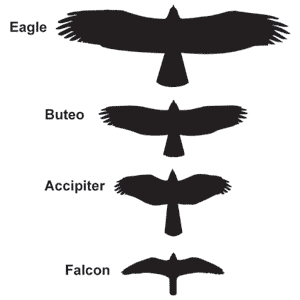 Dihedral – This term refers to species that hold their wings above the horizontal in a shallow “V.”
Dihedral – This term refers to species that hold their wings above the horizontal in a shallow “V.”
Diurnal – ‘Hawk’ is a general term used to describe the entire group of diurnal (active by day) raptors.
Falcon – A member of the genus Falco, a group of 37 falcons and falcon-like birds with long, pointed wings, and long tails. Eastern North American representatives include the American Kestrel, Merlin, Peregrine Falcon, and Gyrfalcon. Falcons are known for their rapid, level flight, and extremely rapid stooping flight.
Glide – To fly, without flapping, usually on somewhat tucked wings, while losing altitude. Gliding birds gain lift by deflecting air over their wings.
Glass – One binocular field. “A glass over rockpile 2” means a bird is one binocular field over the portion of the ridge known as rockpile #2.
Harrier – A member of the genus Circus, a group of 13 largely open-habitat raptors with long wings and long tails. The Northern Harrier is the only harrier in North America. Harriers are known for their slow and low, graceful, coursing flight.
Hawk – Taxonomically speaking, an accipiter, although the term is often used to include all small- to medium-sized raptors, including harriers, buteos, and the Osprey.
Hawkwatch or Hawk Watch – A hawkwatch is a systematic and organized effort to collect standardized migration count data about diurnal raptors.
Immature – “immature” defines a bird that is any age other than adult. Thus, “immature” is a broad term that includes juvenile and sub-adult plumages. A juvenile is an immature bird, but an immature bird is not necessarily a juvenile.
Juvenile – a 1st-year bird (a bird in its first plumage) is what most people call a “juvenile.”
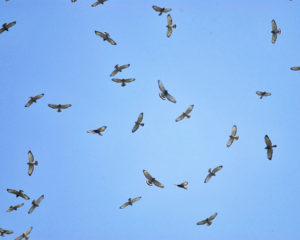
Kettle – To gather together and flock while soaring upwardly in a thermal. The behavior is typical of migrating Broad-winged Hawks. A kettle can be comprised of 10 to >1000 hawks!
Leading line – Leading lines are mountain ranges and shorelines that serve to funnel and concentrate migrating raptors. The Atlantic coastline of New Jersey is a leading line for many raptors, especially falcons. The central Appalachian Mountains of Pennsylvania and Virginia are a leading line for many raptors, especially buteos.
Naked eye bird – A nearby hawk in the sky that one can easily see without the use of binoculars.
Patagium – The forewing between the body and the wrist.
Raptor – The term ‘raptor’ is generally used to describe a bird of prey. The three criteria that ‘technically’ define a raptor are: 1) excellent, forward eyesight, 2) sharp talons for seizing prey, and 3) a hooked bill for tearing prey.
‘Sharpie’ – Nickname given to the Sharp-shinned Hawk
‘Shoulder’ – Nickname given to the Red-shoulderd Hawk
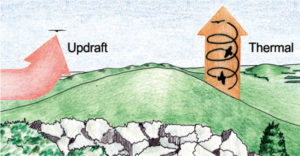 Soar – To gain lift and fly horizontally or upwardly in rising air without flapping. “Slope soaring” occurs when birds soar in updrafts created by winds deflected up and over a hill or mountain. “Thermal soaring” occurs when birds soar in pockets of warm, rising air.
Soar – To gain lift and fly horizontally or upwardly in rising air without flapping. “Slope soaring” occurs when birds soar in updrafts created by winds deflected up and over a hill or mountain. “Thermal soaring” occurs when birds soar in pockets of warm, rising air.
Sub-adult – The term “sub-adult” describes a plumage that occurs after the juvenile (1st-year) plumage but before the adult plumage. Birds that take several years to acquire their adult plumage, such as the Bald Eagle, have one or a few sub-adult plumages. Often, a sub-adult plumage will have a mix of juvenile and adult-like traits or simply appear intermediate between a juvenile and adult plumage.
Thermal – A rising column or pocket of warm air, created when solar radiation differentially heats the earth’s surface. This rising air gives a free lift to the hawks.
TV – Nickname given to the Turkey Vulture
Updraft – The upward movement of air created when horizontal winds are deflected up and over a mountain or hill.
